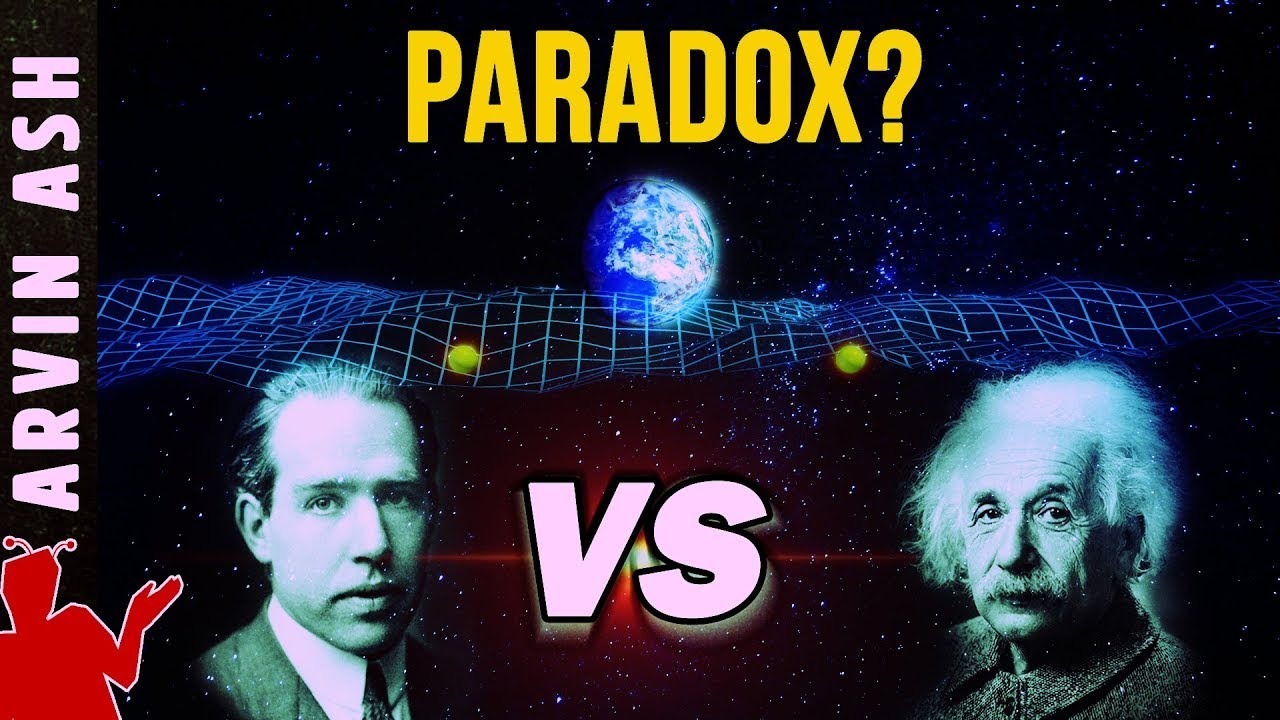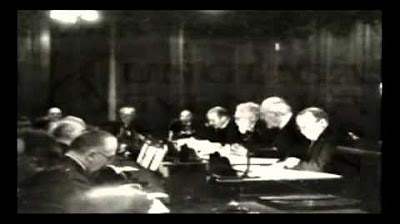The Birth of Quantum Mechanics
TLDRThis script explores the pivotal role Albert Einstein played in the development of quantum mechanics, particularly through his 1905 paper on the photoelectric effect. Contrary to common belief, Einstein was not an opponent but a key advocate, proposing the quantization of light energy. The paper challenged classical physics, offering a quantum theory of light that explained experimental mysteries and made testable predictions, setting the stage for quantum mechanics and influencing subsequent physics research.
Takeaways
- 🌟 In 1900, Max Planck introduced the concept of energy quantization to derive the formula for black body radiation, initially as a mathematical trick.
- 🧠 Albert Einstein later promoted Planck's quantization as a true feature of nature, leading to significant developments in quantum theory.
- 📜 In March 1905, Einstein published a paper that revolutionized the understanding of light and earned him the Nobel Prize in Physics in 1921.
- ⚛️ Despite common beliefs, Einstein was an early and influential advocate of quantum mechanics, proposing the quantum hypothesis for light.
- 🔬 Einstein's work addressed experimental mysteries of the early 1900s, including the photoelectric effect, x-rays, and cathode rays.
- 🔍 Philip Lenard's experiments on the photoelectric effect revealed that electron energy depends on light frequency, not intensity, contradicting classical theories.
- 📈 Einstein's 1905 paper on the photoelectric effect provided a theoretical foundation that matched experimental results, leading to the concept of light quanta.
- 📉 Einstein's quantization theory explained that high-frequency light behaves thermodynamically as quanta, aligning with Planck's findings but applying them to light.
- 🔭 Despite initial resistance, Einstein's ideas gradually gained acceptance and were pivotal in the development of quantum theory.
- 🌐 In 1907, Einstein extended quantization concepts to the vibrations of atoms in solids, contributing to the understanding of heat capacity and solid-state physics.
Q & A
What was Max Planck's initial intention with the discretization of energy?
-Max Planck introduced the discretization of energy as a mathematical trick to derive his successful formula for black body radiation. He did not initially consider it a true feature of nature.
Why is Einstein's 1905 paper significant in the context of quantum mechanics?
-Einstein's 1905 paper is significant because it promoted the concept of energy quantization from a mathematical trick to a fundamental feature of nature, specifically proposing that light itself is quantized, which was a radical idea at the time.
What were the key findings of Albert Einstein's paper on the photoelectric effect?
-Einstein's paper on the photoelectric effect proposed that light consists of energy quanta, and he derived a formula that showed the maximum kinetic energy of ejected electrons depends linearly on the frequency of the incident light, with Planck's constant as the proportionality constant.
What is the photoelectric effect, and why was it a mystery before Einstein's theory?
-The photoelectric effect is the emission of electrons from a material when it is exposed to light. It was a mystery because classical physics could not explain why the energy of the emitted electrons was independent of the light's intensity and depended only on its frequency.
Who was Philipp Lenard, and what is his contribution to the study of cathode rays and x-rays?
-Philipp Lenard was a German experimental physicist who studied cathode rays and x-rays. He introduced important innovations for measuring the properties of cathode rays and conducted extensive research on the photoelectric effect, although he is not credited with the discovery of x-rays.
What is the difference between Einstein's and Planck's approach to energy quantization?
-While Planck proposed that the energy of oscillators in a material is quantized, Einstein took the concept further by suggesting that the energy of light itself is quantized, leading to the concept of light quanta or photons.
What predictions did Einstein make regarding the photoelectric effect in his 1905 paper?
-Einstein made three predictions: 1) There is a linear relation between the electron's energy and the frequency of the incident light. 2) The slope of this line is independent of the material used. 3) The slope corresponds to a new way to measure Planck's constant.
What was the reaction of the physics community to Einstein's quantum theory of light when it was first proposed?
-The physics community was initially skeptical and did not readily accept Einstein's quantum theory of light. It took many years for his ideas to be accepted and recognized as fundamental to quantum mechanics.
Outlines
🔬 Max Planck's Quantum Theory and Einstein's Breakthrough
The first paragraph discusses the inception of quantum theory with Max Planck's discretization of energy leading to the black body radiation formula. It highlights Einstein's role in promoting quantization as a fundamental aspect of nature, not just a mathematical trick. The paragraph sets the stage for Einstein's 1905 paper that introduced the quantum hypothesis, which was a significant departure from classical physics. It also touches upon Einstein's early career, his Nobel Prize-winning work, and the broader context of physics at the turn of the 20th century, including unresolved mysteries related to x-rays and cathode rays.
🌟 Einstein's Quantum Hypothesis and the Photoelectric Effect
The second paragraph delves into Einstein's quantum hypothesis, which extended beyond Planck's law to explain the photoelectric effect. It describes how Einstein's theory challenged classical electromagnetic theory by proposing that light energy is quantized and can be absorbed or emitted only in whole units. The summary also covers Einstein's methodical approach to theoretical physics, his use of mathematical foundations, and his predictions that were later confirmed by experiments.
Mindmap
Keywords
💡Max Planck
💡Quantization
💡Albert Einstein
💡Black Body Radiation
💡Photoelectric Effect
💡Light Quanta
💡Wave-Particle Duality
💡Heat Capacity
💡Dulong-Petit Law
💡Harmonic Oscillators
💡Quantum Mechanics
Highlights
Max Planck introduced the concept of energy quantization in 1900, initially considering it a mathematical trick.
Albert Einstein promoted energy quantization as a fundamental feature of nature, contrary to Planck's initial view.
Einstein's 1905 paper opened the field of quantum mechanics, earning him the Nobel Prize in Physics in 1921.
Einstein was not an opponent of quantum mechanics but one of its most influential advocates.
Einstein proposed a quantum hypothesis beyond Planck's law, solving other experimental mysteries of the time.
Philipp Lenard's work on cathode rays and the photoelectric effect was foundational to quantum theory.
J.J. Thomson's discovery of the electron challenged the understanding of cathode rays as a form of X-rays.
Hertz's discovery of the photoelectric effect in 1887 was a key experimental observation for quantum theory.
Einstein's theory of light quanta provided a new explanation for the photoelectric effect, contradicting classical physics.
Einstein's theory predicted a linear relationship between electron energy and light frequency in the photoelectric effect.
Einstein's theory of light quanta was initially controversial but later supported by experimental evidence.
Einstein's work on the quantum theory of light was a significant departure from the wave theory of light.
Einstein's 1905 paper on light quanta was a foundational work in quantum theory, not just about the photoelectric effect.
Einstein proposed a quantum theory of matter for the heat capacity of solids, challenging the Dulong-Petit law.
Einstein's quantum theory of matter predicted a decrease in heat capacity at low temperatures, differing from classical predictions.
Einstein's radical ideas were eventually tested and supported by experimental results, establishing his reputation in physics.
Transcripts
Browse More Related Video

Quantum Mechanics - Part 1: Crash Course Physics #43

Einstein and the Quantum: Entanglement and Emergence

The EPR Paradox & Bell's inequality explained simply

Einstein's Quantum Physics Theory That Proved Him Wrong | The Secrets Of Quantum Physics | Spark

The Story of Physics ft. Edward Witten

A Brief History of Quantum Mechanics (Part 1)
5.0 / 5 (0 votes)
Thanks for rating: